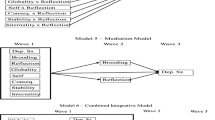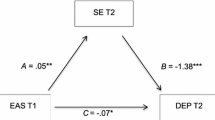Abstract
The goal of the current study was to test the diathesis–stress and causal mediation components of the hopelessness theory of depression in third- and seventh-grade children. The procedure involved an initial assessment of depressive symptoms, hopelessness, and the 3 cognitive styles posited as vulnerability factors by hopelessness theory. The procedure also involved a series of 6 weekly follow-up assessments in which depressive symptoms, hopelessness, and the occurrence of negative events were assessed. A depressogenic attributional style interacted with negative events to predict increases in depressive symptoms in seventh-grade children but not in third-grade children. A depressogenic inferential style about consequences interacted with negative events to predict increases in depressive symptoms in both third- and seventh-grade children. Last, a depressogenic inferential style about the self interacted with negative events to predict increases in depressive symptoms in third- and seventh-grade girls but not boys. None of these interactions were mediated by hopelessness.
Similar content being viewed by others
REFERENCES
Abela, J. R. Z. (1997). The children's cognitive style questionnaire. Unpublished questionnaire, McGill University.
Abela, J. R. Z., & Seligman, M. E. P. (2000). Priming of cognitive vulnerabilities to depression: A test of the diathesis-stress component of the hopelessness theory. Manuscript submitted for publication.
Abramson, L. Y., & Alloy, L. B. (1992). A consensus conference without our consensus. Psychological Inquiry, 3, 225–228.
Abramson, L. Y., Alloy, L. B., & Metalsky, G. I. (1995). Hopelessness depression. In G. M. Buchanan & M. E. P. Seligman (Eds.), Explanatory style (pp. 113–134). Hillsdale, New Jersey: Erlbaum.
Abramson, L. Y., Metalsky, G. L., & Alloy, L. B. (1989). Hopelessness depression: A theory based subtype of depression. Psychological Review, 96, 358–372.
Abramson, L. Y., Seligman, M. E. P., & Teasdale, J. (1978). Learned helplessness in humans: Critique and reformulation. Journal of Abnormal Psychology, 87, 49–74.
Allgood-Merten, B., Lewinsohn, P. M., & Hops, H. (1990). Sex differences and adolescent depression. Journal of Abnormal Psychology, 99, 55–63.
Baron, R. M., & Kenny, D. A. (1986). The moderator-mediator variable distinction in social psychological research: Conceptual, strategic, and statistical considerations. Journal of Personality and Social Psychology, 51, 1173–1182.
Beck, A. T. (1967). Depression: Clinical, experimental, and theoretical aspects. New York: Harper & Row.
Campbell, S. B. (1998). Developmental perspectives. In T. H. Ollendick & M. Hersen (Eds.), Handbook of child psychopathology (3rd ed., pp. 3–35). New York: Plenum.
Coddington, R. D. (1972). The significance of life events as the etiologic factors in the diseases of children. II: A study of a normal population. Journal of Psychosomatic Research, 16, 205–213.
Cohen, J., & Cohen, P. (1983). Applied multiple regression/correlation analysis for the behavioral sciences (2nd ed.). Hillsdale, NJ: Erlbaum.
Cole, D. A. & Turner, J. E., Jr. (1993). Models of cognitive mediation and moderation in child depression. Journal of Abnormal Psychology, 102, 271–281.
Digdon, N., & Gotlib, I. H. (1985). Developmental considerations in the study of childhood depression. Developmental Review, 5, 162–199.
Dixon, J. F., & Ahrens, A. H. (1992). Stress and attributional styles as predictors of self-reported depression in children. Cognitive Therapy and Research, 16, 623–634.
Dobson, K. (1989). A meta-analysis of the efficacy of cognitive therapy for depression. Journal of Consulting and Clinical Psychology, 57, 414–419.
Gladstone, T. R. G., & Kaslow, N. J. (1995). Depression and attributions in children and adolescents: A meta-analytic review. Journal of Abnormal Child Psychology, 23, 597–606.
Haaga, D. A., Dyck, M. J., & Ernst, D. (1991). Empirical status of cognitive theory of depression. Psychological Bulletin, 110, 215–236.
Hammen, C. L., Adrian, C., & Hiroto, D. (1988). A longitudinal test of the attributional vulnerability model of depression in children at risk for depression. British Journal of Clinical Psychology, 27, 37–46.
Hammen, C. L., & Gotlib, I. H. (1992). Psychological aspects of depression. New York: Wiley.
Hilsman, R., & Garber, J. (1995). A test of the cognitive diathesis-stress model of depression in children: Academic stressors, attributional style, perceived competence, and control. Journal of Personality and Social Psychology, 69, 370–380.
Jaycox, L. H., Reivich, K. J., Gillham, J., & Seligman, M. E. P. (1994). Prevention of depressive symptoms in school children. Behaviour Research and Therapy, 32, 801–816.
Joiner, T. E., & Wagner, K. D. (1995). Attributional style and depression in children and adolescents: A meta-analytic review. Clinical Psychology Review, 15, 777–798.
Kanner, A. D., Feldman, S. S., Weinberger, D. A., & Ford, M. E. (1987). Uplifts, hassles, and adaptational outcomes in early adolescents. Journal of Early Adolescence, 7, 371–394.
Kazdin, A. E., French, N. H., Unis, A. S., Esveldt-Dawson, K., & Sherick, R. B. (1983). Hopelessness, depression, and suicidal intent among psychiatrically disturbed inpatient children. Journal of Consulting and Clinical Psychology, 51, 504–510.
Kovacs, M. (1981). Rating scales to assess depression in school children. Acta Paedopsychiatrica, 46, 305–315.
Kovacs, M. (1983). The Children's Depression Inventory: A self-rated depression scale for school-aged youngsters. Unpublished manuscript, University of Pittsburgh School of Medicine, Pittsburgh.
Kutcher, S. P., & Marton, P. (1989). Parameters of adolescent depression: A review. Psychiatric Clinics of North America, 12, 895–932.
Lewinsohn, P., Rohde, P., Seeley, J., & Fischer, S. (1993). Age-cohort changes in the lifetime occurrence of depression and other mental disorders, Journal of Abnormal Psychology, 102, 110–120.
Metalsky, G. I., & Joiner, T. E., Jr. (1992). Vulnerability to depressive symptomatology: A prospective test of the diathesis-stress and causal mediation components of the hopelessness theory of depression. Journal of Personality and Social Psychology, 63, 667–675.
Nolen-Hoeksema, S., Girgus, J. S., & Seligman, M. E. P. (1986). Learned helplessness in children: A longitudinal study of depression, achievement, and attributional style. Journal of Personality and Social Psychology, 51, 435–442.
Nolen-Hoeksema, S., Girgus, J. S., & Seligman, M. E. P. (1992). Predictors and consequences of childhood depressive symptoms: A five-year longitudinal study. Journal of Abnormal Psychology, 101, 405–422.
Panak, W. F., & Garber, J. (1992). Role of aggression, rejection, and attributions in the prediction of depression in children. Development and Psychopathology, 1992, 145–165.
Reich, T., Van Eerdewegh, P., Rice, J., Mullaney, J., Klerman, G., & Endicott, J. (1987). The family transmission of primary depressive disorder. Journal of Psychiatric Research, 21, 613–624.
Rosenthal, R. (1984). Meta-analytic procedures for social research. London: Sage.
Robinson, N. S., Garber, J., & Hilsman, R. (1995). Cognitions and stress: Direct and moderating effects on depressive versus externalizing symptoms during the junior high school transition. Journal of Abnormal Psychology, 104, 453–463.
Seligman, M. E. P., Peterson, C., Kaslow, N. J., Tenenbaum, R. L., Alloy, L. B., & Abramson, L. Y. (1984). Attributional style and depressive symptoms among children. Journal of Abnormal Psychology, 93, 235–241.
Seligman, M. E. P., Reivich, K., Jaycox, L., & Gillham, J. (1995). The optimistic child. Boston: Houghton Mifflin.
Turner, J. E., & Cole, D. A. (1994). Developmental differences in cognitive diatheses in child depression. Journal of Abnormal Child Psychology, 1994, 15–32.
Author information
Authors and Affiliations
Rights and permissions
About this article
Cite this article
Abela, J.R.Z. The Hopelessness Theory of Depression: A Test of the Diathesis–Stress and Causal Mediation Components in Third and Seventh Grade Children. J Abnorm Child Psychol 29, 241–254 (2001). https://doi.org/10.1023/A:1010333815728
Issue Date:
DOI: https://doi.org/10.1023/A:1010333815728




